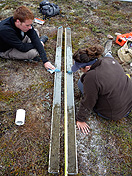News
Ice sheets can expand in a geologic instant, Arctic study shows
-
 Print
Print -
 Comments
Comments
-

UB students Shanna Losee and Will Phillips inspect a sediment core from Pluto Lake. The thick, gray layer was deposited during an advance of Jakobshavn Isbrae about 9,200 years ago.
A fast-moving glacier on the Greenland Ice Sheet expanded in a geologic instant several millennia ago, growing in response to cooling periods that lasted not much longer than a century, according to a new Arctic study.
The finding adds to a growing body of evidence indicating that ice sheets can not only shrink in response to abrupt warming, but also reverse course and expand in response to abrupt cooling. One conclusion: The current shrinking of some marine-terminating outlet glaciers may not be irreversible, as some experts have feared.
The research, conducted by scientists from UB and partner institutions, will appear in an upcoming edition of Geophysical Research Letters. The study found that twice in the early Holocene period—9,200 years ago and then 8,200 years ago—Jakobshavn Isbrae, a glacier on Greenland’s west coast, overcame rapid shrinkage to expand during brief cooling periods.
“When we look at the geologic record, we are finding out that the large rivers of ice that drain ice sheets are extremely sensitive to climate change, both warming and cooling. Probably the larger these rivers of ice are, the more sensitive they are to climate change,” says Jason Briner, UB associate professor of geology who led the research with UB PhD student Nicolás Young.
Young was lead author of the study. Other partners included Beata Csatho and Greg Babonis from UB, as well as Yarrow Axford from Northwestern University, Dylan Rood from Lawrence Livermore National Laboratory and the University of California-Santa Barbara, and Robert Finkel from the University of California-Berkeley.
Jakobshavn Isbrae is a large tongue of ice extending out to sea from Greenland’s west coast. Briner has been studying the glacier for several years, taking teams of students to the Arctic to piece together the glacier’s history by reading the scarred landscape that surrounds it.
In their most recent study, the scientists dated glacially deposited sediment and debris from two research sites to determine that Jakobshavn Isbrae underwent abrupt expansions about 9,200 and 8,200 years ago—times that coincided with cooling periods that lasted little more than a century.
First, the team analyzed sediment from the bottom of the Pluto Lake basin, which sits along the path of one of Jakobshavn’s past expansions. What the researchers found were three distinct layers: a single layer of rocky material about 9,200 years old sandwiched between two layers of organic material (the remains of dead plants).
The pattern implies that Jakobshavn was in a cycle of advance and retreat about 9,200 years ago, says Young. During that time, he explains, Jakobshavn most likely expanded to the edge of the lake, where it began dumping melt water and rocky debris into the lake, forming the middle sediment layer. Later, when the region warmed and Jakobshavn receded, plant matter began accumulating, returning the lake bottom to its usual composition.
In addition to Pluto Lake, the scientists studied a moraine, a trail of debris marking Jakobshavn’s path of advance during a different period of growth. (As glaciers expand, they carry and deposit rocks, soil and other matter along their path of advance. The deposits form a moraine.)
By dating boulders on the moraine, the scientists determined that the formation was created about 8,200 years old.
Though the team was unable to figure out how quickly Jakobshavn was growing when it formed the moraine and dumped silt into Pluto Lake, the fact that the glacier grew at all during these times suggests a high sensitivity to climate change. The cooling periods that coincided with the glacier’s growth cycles could be measured on a centennial scale—the blink of an eye in the context of geology.
The study was funded by the National Science Foundation’s Program of Geography and Spatial Science. The findings build on a body of research showing that large, marine-calving glaciers can respond rapidly and dramatically to abrupt climate change.
About two years ago, Briner and his colleagues unearthed evidence indicating that glaciers in deep ocean water can undergo periods of rapid retreat, where they can shrink even more quickly than has recently been observed. They reported their findings in Nature Geoscience.
More recently, in 2011, Briner’s team published a study in Quaternary Science Reviews demonstrating that glaciers also can grow at a dramatic rate. In that paper, they outlined how Jakobshavn Isbrae, which retreated about 40 kilometers inland between 1850 and 2010, expanded outward at a similar pace during a cooling period about 200 years ago.

Reader Comments